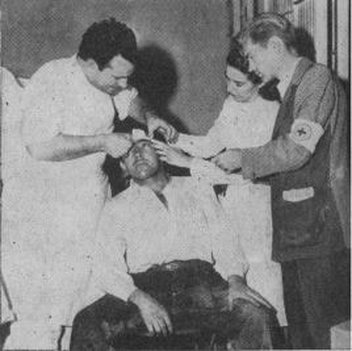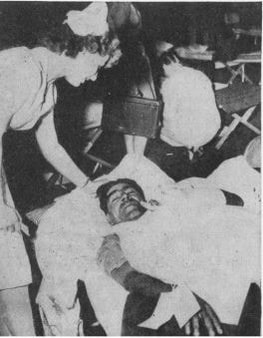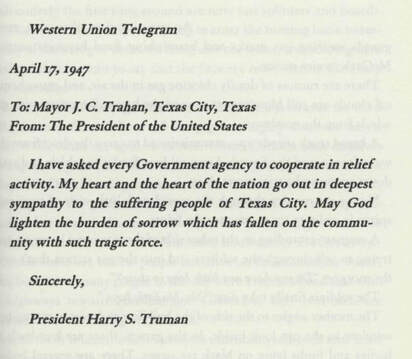Survivors come together to help
Source: Houston Chronicle, circa April 1947
Source: Houston Chronicle, circa April 1947
Recovery
"The air was polluted with heaven knows what, but there was no time to consider things like that. Fires had to be put out, injured persons treated, the dead identified, removed from the temporary morgues, and buried. Almost everyone knew someone who was injured or killed."
-Beverly Benson Hager, Survivor of the Texas City Disaster1
-Beverly Benson Hager, Survivor of the Texas City Disaster1
|
Crewman of the Grandcamp examined
Source: The Red Cross, April 1947. |
Volunteers from across Texas and the United States came to help. The Red Cross being one of the main contributors, provided nearly 5,000 volunteers and 4,000 people trained in first aid came soon after. Temporary shelters were made for those whose homes were destroyed. Other groups such as the Girls Scouts, Boy Scouts, student nurses, and the military sent volunteers as well.
|
Source: Texas DPS Museum
"There were lots of volunteer workers who came up, got pans of water, and helped clean the patients and helped to find out their names. They really aided us tremendously."
-Allie Fay Molsbee, Student Nurse2
-Allie Fay Molsbee, Student Nurse2
|
The tragedy caused many changes not just in Texas City but nationwide. Due to the severe injuries of some of the victims, new methods of trauma care were created. Those taking care of the injured soon found a great need for blood, an issue in a small city with thousands in need. After the disaster, the American Association of Blood Banks was created to help in situations like the tragedy in the future.
|
Survivor receives aid
Source: The Red Cross, April 1947. |
"The 1947 Disaster had a major impact on how hazardous materials are handled- it is still used as a case study for industrial safety courses today. The Disaster triggered the very first class action lawsuit against the United States, and when the plaintiffs lost the lawsuit, Congress passed legislation to compensate the victims."
-Amanda Vance, Curator at the Texas City Museum3
-Amanda Vance, Curator at the Texas City Museum3
One of the most important changes was the creation of new laws governing how materials and chemicals were handled and stored on ships.
|
A letter from President Harry Truman
Source: City on Fire: The Explosion That Devastated a Texas Town and Ignited a Historic Legal Battle, 2003. |
The disaster in Texas City brought light to issues in the management of emergency situations. Before, when tragedy struck, the response was chaos and disorder. Texas City officials saw this issue and chose to create agencies that help in emergency situations. The Texas Department of Public Safety and the Texas Emergency Management Assistance Team were established to help facilitate aid in future tragedies. One of the major ways they helped is by creating headquarters that provide structure and notify everyone involved in rescuing and recovery what to do.
|
"We shall never forget the courageous acts of kindness shown to Texas City by neighboring cities."
-Lois Castanie, Survivor of the Texas City Disaster4
-Lois Castanie, Survivor of the Texas City Disaster4
Source: Texas DPS Museum
Footnotes:
1. We Were There: a Collection of the Personal Stories of Survivors of the 1947 Ship Explosions in Texas City, Texas, Commonly Referred to as the Texas City Disaster. [Texas City. Tex.] : [Mainland Museum of Texas City], [1997], 1997.
2. Molsbee, Allie Fay. “Students Give Disaster Service in Galveston: A Student Describes Her Part in the Emergency Following the Texas City Disaster .” The American Journal of Nursing, vol. 47, no. 6, June 1947, p. 414.
3. Vance, Amanda. "Interview with Amanda Vance." Personal Correspondence. 11 Jan. 2019.
4. We Were There: a Collection of the Personal Stories of Survivors of the 1947 Ship Explosions in Texas City, Texas, Commonly Referred to as the Texas City Disaster. [Texas City. Tex.] : [Mainland Museum of Texas City], [1997], 1997.
1. We Were There: a Collection of the Personal Stories of Survivors of the 1947 Ship Explosions in Texas City, Texas, Commonly Referred to as the Texas City Disaster. [Texas City. Tex.] : [Mainland Museum of Texas City], [1997], 1997.
2. Molsbee, Allie Fay. “Students Give Disaster Service in Galveston: A Student Describes Her Part in the Emergency Following the Texas City Disaster .” The American Journal of Nursing, vol. 47, no. 6, June 1947, p. 414.
3. Vance, Amanda. "Interview with Amanda Vance." Personal Correspondence. 11 Jan. 2019.
4. We Were There: a Collection of the Personal Stories of Survivors of the 1947 Ship Explosions in Texas City, Texas, Commonly Referred to as the Texas City Disaster. [Texas City. Tex.] : [Mainland Museum of Texas City], [1997], 1997.
|
John Castaneda, Nicolas Gonzales, Soraida Sosa, Isaac Veloz
Senior Group Website Website Student Generated Words: 1152 Process Paper Student Generated Words: 484 Media Duration: 3:45 |
Best viewed at resolutions
of 1280 x 1024 or greater on Google Chrome |


